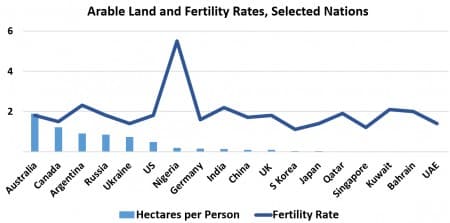In the period 1975 to 2019, world population increased at an average pace of 83 million per year. The 2019 increase was the difference between approximately 140 million births and 57 million deaths. The annual emissions of carbon dioxide from fossil fuel combustion, cement manufacture and deforestation are currently 40 billion metric tons, of which almost half remains airborne. Two global challenges are thus the stabilization of world population and the stabilization of atmospheric carbon dioxide concentration. The following argument demonstrates it is not possible to reduce world population to a sustainable 3 billion after it has peaked at approximately 11 billion around 2100.
Population growth creates the need for increased food production. Cereals are the most important crops for food and livestock feed; globally, 45 percent of the cereal harvest is consumed by humans and 35 percent by livestock; the remainder is used for other purposes, including seed, ethanol for blending with gasoline, and alcoholic beverages such as beer, whiskey, vodka and sake.
The rise in world cereal production since the 1960s is mainly due to two technological advances. The first was Haber-Bosch ammonia synthesis, in which atmospheric nitrogen is fixed as ammonia – with reactive nitrogen essential for photosynthesis, DNA, proteins and enzymes. Both chemist Fritz Haber and chemical engineer Carl Bosch were awarded the Nobel Prize in 1918 and 1931, respectively. Production of Haber-Bosch ammonia began in 1913, and consumption of nitrogen fertilizer now exceeds 115 million metric tons per year, more than half of which is applied to cereals. Outside China, which uses coal, ammonia synthesis relies on natural gas.
The second advance was the Green Revolution that began in 1965, after agronomist Norman Borlaug had bred varieties of dwarf wheat that are sturdier than traditional varieties and give higher yields in response to heavier applications of fertilizer. Borlaug was awarded the Nobel Peace Prize in 1970. The breeding of hybrid maize by Illinois farmer Lester Pfister in the 1930s paralleled the work of Borlaug. The International Rice Research Institute launched high-yielding semi-dwarf rice in 1966.
Related: What Happens If U.S. Shale Goes Bust? Global cereal yields more than tripled from 1.16 metric tons per hectare in 1950 to 4 tons in 2018. In the same period, the harvested cereal area increased from 600 million hectares to 730 million. If the average annual yield increase from 1992 to 2017 of 52 kilograms per hectare continues to 2050, the yield that year would be 5.8 tons per hectare, thereby raising production to 4.2 billion tons. This assumes no change in the harvested cereal area. The Population Reference Bureau projects the global population in 2050 to be 9.85 billion, so cereal production per person would be 420 kilograms, 10 percent above the current 380 kilograms. The annual nitrogen application on the world cereal area would rise by at least 50 percent. It is possible, however, that grain production per person remains at the current level, or even declines as a result of global warming.

Stressed: Fertilizer and dwarf varieties hiked cereal yields, expanding population in nations lacking arable land (Source: World Bank)
The success of the Green Revolution created three major ecological problems:
1. Globally, about half the applied nitrogen is taken up by the crop plants; the remainder volatilizes in the form of ammonia and nitrous oxide, a greenhouse gas, or leaches to groundwater, resulting in eutrophication, or the formation of algae, in rivers, lakes and coastal waters. This creates “dead zones” in which fish cannot live.
2. Many soils are deficient in nutrients. Inadequate amounts of nitrogen, phosphorus and potassium are remedied by fertilizers – but other nutrients, needed in small or trace amounts, are seldom applied. These include calcium, magnesium, sulfur, iron, boron, manganese, zinc, copper, molybdenum and nickel. As agronomist Lloyd Evans put it: “These nutrients are the Davids which can render the Goliaths of nitrogen, phosphorus and potassium helpless in both plants and animal husbandry.”
3. Approximately 40 percent of global irrigation water is obtained by pumping groundwater from tube wells. This has resulted in the depletion of aquifers and reduced groundwater levels, thereby contributing to global sea-level rise.
If the ratio of a country’s population to its arable area does not exceed two persons per arable hectare, its population could be fed adequately without nitrogen fertilizer or grain imports. If this ratio were the average on the world’s 1.6 billion arable hectares, world population would be 3.2 billion. Reducing world population to this number would require China to reduce its 1430 million population to 250 million, and India’s population of 1370 million to 340 million. Japan has 27 persons per arable hectare and Egypt 34; these two countries would have to reduce populations even more drastically. Japan’s population of 126 million would probably fall to 101 million by 2050, while Egypt’s 100 million population would likely reach 166 million in 2050.
The “2 per arable hectare” criterion cannot be applied to countries with extremely small arable areas, such as Singapore, Kuwait, Qatar, Bahrain and the United Arab Emirates. Countries that have less than two persons per arable hectare include Russia, Ukraine, Canada, Australia and Argentina. The ratio in the United States is just over 2, and the world average is certain to reach 5 in 2023. Major population reductions would require more than a century with the fertility rate at one child per woman. The fertility rate in South Korea fell to 0.98 in 2018, the world’s lowest; if this rate continues, the proportion of the population in the 65+ age-group would rise to 50 percent after two generations. Few countries will follow South Korea’s example, or even that of Japan, with its fertility rate of 1.4. It is obvious that a reduction of the world’s population to 3 billion is impossible.
Related: This Supermajor Is About To Slash Permian Oil Production
The second global challenge is the rising atmospheric carbon dioxide concentration. In 1906, the Swedish scientist Svante Arrhenius calculated that a doubling of the concentration – then 300 parts per million – would cause a rise of 2.1 degrees Celsius in global average surface temperature. Recent estimates vary, but it is probable that the rise will exceed 2 degrees C and virtually certain that it will exceed 1.5 degrees, generally considered the “safe” limit. It is most unlikely that the concentration can be stabilized at less than double the pre-industrial level of 280 parts per million. Researchers estimate the rise in sea level during the period from 2005 to 2100 at 650 millimeters, with an uncertainty of 120 millimeters either way. The rise could ultimately reach 3 meters, as it did during the Eemian interglacial period 130,000 years ago.
ADVERTISEMENT
Stabilizing the CO2 concentration – now 412 ppm and rising at over 2 ppm per year – at 450 ppm, as many environmentalists propose, would mean leaving most of the recoverable fossil fuel reserves underground. The world would have to complete phasing out of fossil fuel by 2050, and this is not feasible. In 2018, fossil-fueled power plants generated 61 percent of the global generation of 24,800 terawatt-hours. In 2050, fossil electricity has been optimistically projected to be 43 percent of a global generation of 44,000 terawatt-hours. This means that fossil-based electricity generation in 2050 will exceed that of 2018.
There are measures that could make the population and carbon dioxide stabilizations be attained more rapidly, but they are either coercive or involve lower living standards in the short- and medium-term. Fossil fuels have enabled humanity to achieve scientific and technological advances undreamed of prior to the Industrial Revolution. It is not surprising that there is a price to pay.
By Yale Global Online
More Top Reads From Oilprice.com:
- Oil Majors Are Preparing For $10 Oil
- Not Even China Can Save Oil Markets This Time Around
- The Boldest Permian Plays To Watch As The Oil Market Circles The Drain


















